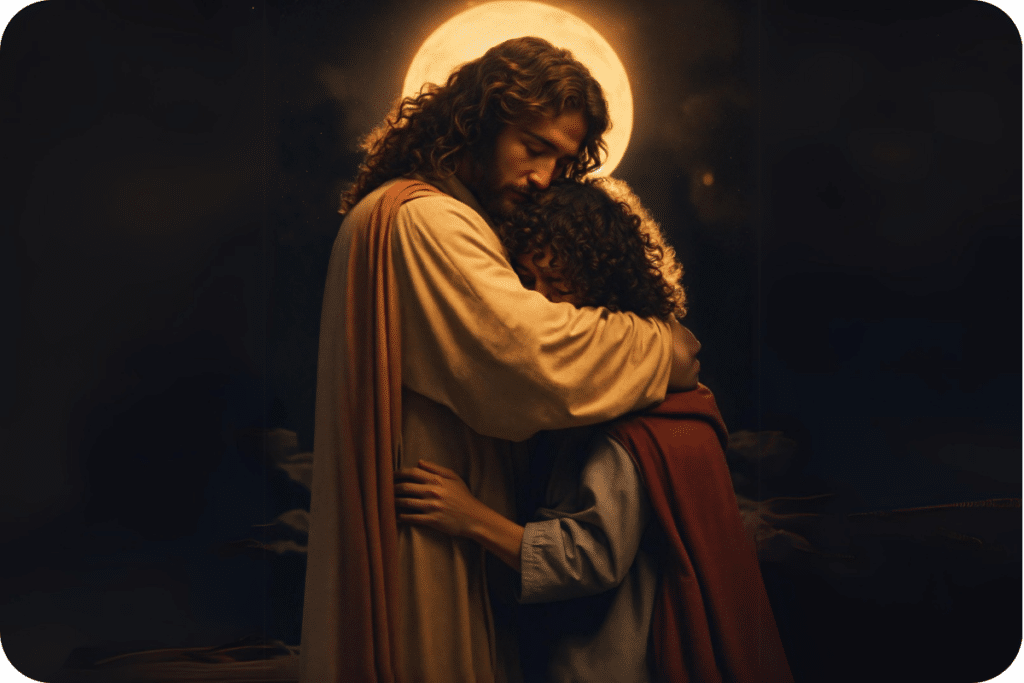GRACEFUL GOMER IN THE BIBLE
The story of Gomer in the Bible, the wife of the prophet Hosea, is a powerful allegory of redemption, grace, and unconditional love. Despite her promiscuous nature, Gomer’s narrative showcases the transformative power of divine love and forgiveness.

Hosea’s marriage to Gomer, symbolizing Israel’s relationship with God, highlights the contrast between God’s love and human judgment. Gomer’s story offers a compelling message of redemption and forgiveness, emphasizing God’s unwavering commitment to His people, even in the face of their failures.
Background and Marriage of Gomer in the Bible
Hosea’s Command
The story of Gomer in the Bible, Book of Hosea is a powerful allegory of God’s unconditional love and the transformative power of divine forgiveness. Despite Gomer’s promiscuous background, her marriage to the prophet Hosea symbolizes Israel’s unfaithfulness to God, the divine Husband. Hosea’s commitment to Gomer, even after her adultery, mirrors God’s unwavering love for His people, despite their spiritual harlotry.
Gomer’s narrative demonstrates that no one is beyond the reach of God’s redemption, as He pursues His wayward children with compassion and grace. This profound metaphor resonates across the ages, offering a compelling message of hope and restoration for all who have strayed from the path of righteousness.
The Significance of Gomer’s Name
The name “Gomer” may not have a specific biblical meaning, but it can be associated with the idea of completion or bringing to an end in Hebrew. This symbolic meaning could suggest Gomer’s role in fulfilling God’s plan to demonstrate His relationship with Israel through the metaphor of Hosea’s marriage.
The story of Gomer in the Bible represents the unfaithfulness of Israel, but also the transformative power of divine love and forgiveness, as Hosea’s redemption of his wife mirrors God’s unwavering commitment to His people. Gomer’s narrative serves as a profound allegory that resonates across the ages, offering a compelling message of hope and restoration.
Children as Prophetic Signs
Gomer and Hosea have three children, Jezreel, Lo-Ruhamah, and Lo-Ammi – each carry prophetic names that symbolize the deteriorating relationship between God and Israel.
- Jezreel: Means “God sows” or “God scatters,” symbolizing the impending judgment on Israel (Hosea 1:4-5).
- Lo-Ruhamah: Means “not loved” or “no mercy,” indicating God’s withdrawal of compassion due to Israel’s sins (Hosea 1:6).
- Lo-Ammi: Means “not my people,” signifying the broken relationship between God and Israel (Hosea 1:9).
These symbolic names powerfully convey the tragic consequences of Israel’s spiritual adultery and rejection of God, while also hinting at the possibility of future restoration and redemption through God’s enduring love and mercy.
Gomer’s Infidelity
Symbol of Israel’s Unfaithfulness
Gomer’s unfaithfulness in Hosea 2:5 symbolizes Israel’s spiritual adultery through idolatry and forsaking their covenant with God. Gomer’s pursuit of other lovers represents Israel’s pursuit of false gods and reliance on foreign alliances. This parallel highlights the spiritual harlotry of Israel, which God condemns. The story of Hosea and Gomer serves as a powerful allegory of God’s unwavering love and forgiveness, despite Israel’s unfaithfulness.
Hosea’s Heartbreak

Hosea’s personal suffering due to Gomer’s betrayal mirrors God’s sorrow over Israel’s infidelity. Despite Gomer’s actions, Hosea’s enduring love and efforts to reclaim her reflect God’s unwavering commitment to redeem His people. This parallels God’s relentless pursuit of Israel, despite their spiritual adultery. Hosea’s story illustrates God’s fierce love and desire for intimacy with His people, even when they stray.
The Redemption of Gomer in the Bible
Hosea’s Redeeming Love
Hosea’s redemption of Gomer in Hosea 3:1-2 symbolizes God’s redemption of Israel. Hosea pays a price of fifteen shekels of silver and a quantity of barley, illustrating the cost of redemption and his dedication to restoring Gomer. This act mirrors God’s unwavering love and commitment to redeem His people despite their spiritual adultery.

The payment in kind, a homer and a half of barley, represents the value of Gomer, while the monetary amount, fifteen shekels of silver, symbolizes the redemption of a slave. This powerful allegory underscores God’s relentless pursuit of His people, even in the face of their infidelity, and the transformative power of His love and forgiveness.
Renewal of Covenant
After redeeming Gomer, Hosea calls for a period of purification and faithfulness (Hosea 3:3). This reflects the renewal of the covenant between God and Israel, emphasizing themes of repentance and reconciliation. Hosea’s instruction for Gomer to abstain from sexual relations and not have another man symbolizes Israel’s need to separate from their idolatrous ways and return to God.
This period of purification prepares the way for a restored relationship between God and Israel, mirroring the covenant renewal in Leviticus 26 and Deuteronomy 30. The story of Hosea and Gomer serves as a powerful allegory of God’s unwavering love and commitment to redeem His people, despite their infidelity.
Theological Themes in Story of Gomer in the Bible
Unconditional Divine Love

The story of Gomer in the Bible, Book of Hosea powerfully illustrates the depth of God’s unconditional love. Despite Gomer’s repeated betrayal, Hosea’s unwavering commitment to redeem her symbolizes God’s steadfast love for Israel . Hosea’s actions mirror God’s relentless pursuit of His people, even in the face of their spiritual adultery.
Call to Repentance

Gomer’s redemption in Hosea 3 symbolizes Israel’s need for repentance and return to God. Her story urges believers to turn away from spiritual waywardness and embrace a renewed relationship with God. Gomer’s call to change, represented by her abstinence from sexual relations and refraining from marrying another man, parallels Israel’s need to separate from idolatrous ways and return to God. This narrative emphasizes the transformative power of God’s love and forgiveness, encouraging believers to seek redemption and restoration through a renewed commitment to God.
Hope of Restoration

Gomer’s eventual restoration in Hosea’s narrative points to the hope of reconciliation with God. Hosea 2:14-23 speaks of a future where God will restore Israel, betrothing them in righteousness, justice, and love. This promise underscores the transformative power of God’s grace, capable of restoring even the most broken relationships.
Just as Hosea redeemed Gomer in the Bible and called her to a period of purification, God will lead Israel through a time of isolation before fully restoring their covenant relationship. This allegory offers a compelling message of redemption, emphasizing that no one is beyond the reach of God’s unfailing love and forgiveness.
Lessons From Gomer in the Bible
1. Symbol of Spiritual Adultery: Gomer’s life symbolizes Israel’s unfaithfulness to God through idolatry and disobedience. Her actions serve as a stark reminder of the consequences of straying from God’s commands and pursuing worldly desires.
2. God’s Unfailing Love: Despite Gomer’s repeated unfaithfulness, Hosea’s love and his efforts to redeem her mirror God’s enduring love for His people. It teaches us that no matter how far we stray or how many times we fail, God’s love and grace are always available for those who repent and turn back to Him.
3. Redemption and Restoration: Hosea’s decision to redeem Gomer from her life of harlotry illustrates the concept of redemption and restoration. It shows us that God is willing to forgive and restore us if we genuinely repent and seek His forgiveness.
4. Consequences of Sin: Gomer’s life also highlights the consequences of sin and disobedience. Her choices led to personal suffering and separation from her family, illustrating the broader consequences that sin can have on individuals and communities.
5. Call to Repentance: Gomer’s story serves as a call to repentance for us today. It reminds us of the importance of acknowledging our sins, turning away from them, and returning to a faithful relationship with God.
6. Trust in God’s Promises: Despite the challenges and difficulties Gomer faced, her story ultimately points to God’s promises of redemption and renewal. It encourages us to trust in God’s faithfulness and rely on His promises, even in times of trial and uncertainty.
7. Forgiveness and Second Chances: The story of Gomer in the Bible underscores the importance of forgiveness and second chances. It teaches us that God is ready to forgive us when we repent, and He gives us opportunities to start afresh and live according to His will.
8. Unconditional Love: Above all, Gomer’s life teaches us about God’s unconditional love. It demonstrates that His love is not based on our performance or merit but on His character and grace. It encourages us to accept and experience this love fully in our lives.
Characteristics of Gomer in the Bible

- Symbolic Representation: Gomer in the Bible, is symbolic of the nation of Israel’s spiritual condition. Her marriage to the prophet Hosea and her subsequent actions represent Israel’s unfaithfulness and idolatry towards God.
- Marital Relationship: Gomer in the Bible, is introduced as the wife of Hosea, whom he marries as part of God’s command to illustrate Israel’s relationship with God (Hosea 1:2-3). Her marriage serves as a living parable of Israel’s infidelity and God’s steadfast love.
- Background of Harlotry: Gomer in the Bible, is described as a “woman of harlotry” (Hosea 1:2), suggesting a background of immoral behavior or promiscuity. This background underscores the depth of God’s grace in choosing her as an instrument to convey His message.
- Motherhood: Gomer bears children with Hosea, whose names—Jezreel, Lo-Ruhamah, and Lo-Ammi—symbolically reflect God’s judgments on Israel for their sins (Hosea 1:4-9). This aspect highlights Gomer’s role in illustrating the consequences of Israel’s spiritual adultery.
- Infidelity and Redemption: Gomer’s unfaithfulness to Hosea mirrors Israel’s unfaithfulness to God. Despite her actions, Hosea’s persistent love and his act of redeeming her from her life of harlotry symbolize God’s mercy and His desire to reconcile with His people.
- Abjectness and Redemption: Her life serves as a vivid portrayal of God’s desire to restore His people despite their waywardness and sinfulness.
Legacy of Gomer in the Bible
An Allegory of Grace
The story of Gomer in the Bible, in Hosea serves as an allegory of God’s grace. Despite her promiscuity and infidelity, God’s love for her remains steadfast. Hosea’s relentless pursuit and redemption of Gomer symbolize God’s unwavering commitment to restore His relationship with Israel, despite their spiritual adultery. Gomer’s narrative illustrates how God’s love can redeem and restore, making her story a timeless testament to the power of divine grace.
A Source of Hope
The story of Gomer in the Bible offers hope to those feeling distant from God. Despite her repeated unfaithfulness, God’s love and mercy remain available for restoration and renewal. Hosea’s relentless pursuit of Gomer symbolizes God’s unwavering commitment to redeem His people.
Gomer’s narrative reassures that, regardless of past mistakes, God’s transformative grace is always available for forgiveness and renewal. This enduring message encourages individuals to seek forgiveness and embrace God’s unconditional love, offering a powerful reminder of His relentless pursuit of those who stray.
Conclusion
The story of Gomer in the Bible, Book of Hosea, despite its brevity, delivers profound lessons about love, redemption, and divine grace. Gomer’s life, intertwined with Hosea’s prophetic mission, serves as a powerful allegory of God’s unwavering love for His people, the Israelites.Gomer’s unfaithfulness to Hosea mirrors the spiritual adultery of Israel, as they abandoned their covenant with God to pursue false idols.
Yet, Hosea’s relentless pursuit and redemption of Gomer in the Bible symbolizes God’s compassion and desire to restore His relationship with His wayward people.Gomer’s narrative challenges us to reflect on our own relationship with God, reminding us that no one is beyond the reach of His grace and forgiveness.
Her story offers hope, emphasizing the transformative power of divine love and the possibility of redemption and renewal for all who have strayed from the path of righteousness. Gomer’s life stands as a timeless testament to God’s unfailing commitment to His people.


1 thought on “50. GRACEFUL GOMER IN THE BIBLE”